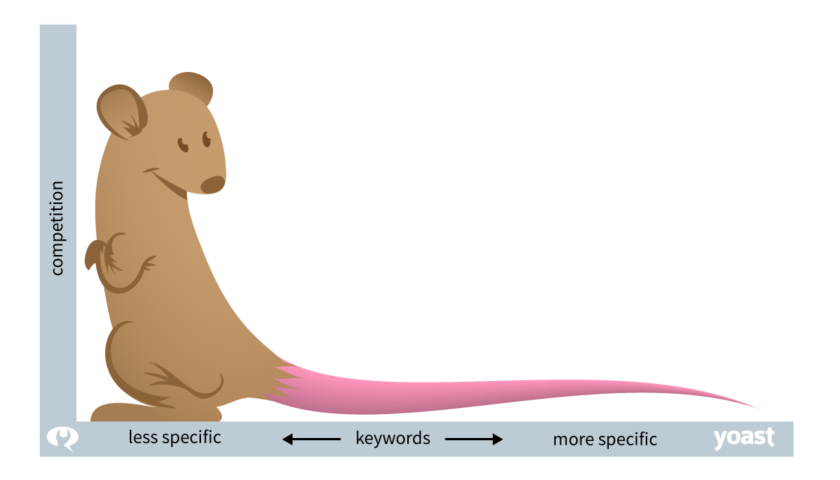Reasons to Target Long-tail Keywords
Are you Exhausted? Tired?
Trying to rank for the same high- competition keywords as your contenders?
Trying to improve, your website’s performance?
There is a ‘two and half’ words to help you to solve this problem: Long- Tail Keywords
What is Long-tail Keyword?
Long- tail Keywords are those three and four and sometimes as many as five keyword phrases, which are very, very specific and highly focussed to whatever you are selling.
Whenever a customer uses a highly specific search phrase, they tend to be looking for exactly what they are actually going to buy. Such specific, fixed searches are more likely to get converted to sales than generic searches.
Why should you care about Long-tail Keywords?
Because they can drive a ton of high converting traffic to your website and eventually increase the performance of your website and revenue for your business.
For example, if you are a company that sells classic furniture. The possibility are your pages are never going to appear near the top of an organic search for ‘’furniture’’ as there is too much competition.
In this case if you specialize, the word, like contemporary art- deco furniture, the keywords like ‘’contemporary art- deco influenced semi- circle lounge’’ are reliably going to find those customers looking for the exact product.
Long- tail keywords are more specific, that means visitors that land on your website from a long tail search term are more qualified.
According to our research, we found a lot many company’s organic traffic skyrocketed, after they started using keyword research strategies. In the blog ahead, I will share how to take advantage of long- tail keywords to get piles of converting traffic with the least amount of effort.
You must know that vast majority of Google searches are very particular, specified and unpopular aka long- tail
Why are they called Long- tail Keywords?
Well, in the graph by hubspot.com presented below, the vast majority of searches fall in the long, trailing off end of the search engine curve, hence, termed as Long- tail Keywords.
Another simplified graph from ahrefs.com presented below, this explains clearly less popular words that fall on the long tail of the search are called long- tail keywords.
Fun fact about Long- tail Keywords
A common misconception among SEO’s is that the shorter search queries have higher search volumes, and the longer search queries have shorter search volumes.
Here’s to burst that myth:
Picture Source: ahrefs
You can see clearly in the example above, that four and five word search queries clearly have higher search volumes than the two word search query.
Some more examples on the same,
Picture Source: ahrefs
Key Note: Short search queries can be ‘’long tail keywords’’ and long queries can be ‘’head keywords’’. So you cannot and should not, try to determine keyword popularity by looking at the number of words in the query.
In other words don’t be biased, and judge the search popularity by the number of words in the query.
How to determine Long- Tail Keywords
If you are having trouble to find the long- tail keywords, just go to Google.com and enter your head terms in the search box and let Google suggest you some long tail variations.
Picture Source: ahrefs
The search suggestions above are more specific and less popular searches. To convert the visitors, provide videos, pictures, offers and contextual content. By further filtering the audience you will see more conversions from this super qualified traffic, and be able to monetize your long tail search efforts adequately.
Simultaneously, you can also check the People also ask box.
Picture Source: ahrefs
Also, do check for the ‘’Searches related to’’ area at the bottom of the search page.
These give an idea about other, less popular words, but more specific searches people are making about that topic.
Collecting all these keywords manually from the Google is time consuming and quite hectic. So you will have to use a professional keyword research tool to help you find thousands of useful and worthy long- tail keywords in a matter of seconds.
kwfinder is here to solve your problem. Just enter one base keyword, specify the location and language and then click on ‘’Analyze’’ and you can get volumes of keyword ideas.
Picture Source: ahrefs
This can be considered, one of the best ways that you might not have considered before, to find long- tail keywords in your industry.
Below are a few more techniques, for finding things that people in your niche may be searching on Google.
- Think from a customer’s point of view- Think how your customers would look for the products or the services you offer. How would they phrase the sentence? What language will they use?
- Interact with your customers- There is no better way of finding out how your customers think and search for your products than by just talking to them.
- Follow online community threads- Check Industry forums like Facebook groups and other social media channels to see what your customers are asking and how they are phrasing the questions.
How to Gain Heavy Traffic from Long- tail Keywords
Long- tail keywords are easier to rank than head keywords.
Below taken is an example of the top ranking pages for the long- tail keyword ‘’turmeric weight loss’’
Picture Source: ahrefs
Above, most of the top ranking pages have fewer than 20 referring domains. So, in this case if you are to create a page on similar topic and build some links to it, you could quite easily rank in the top 10.
Now let’s compare the above search with a ‘’popular’’ head term – weight loss
Picture Source: ahrefs
You can easily spot the difference here; the top ranking pages here have loads of back links, and if you were to create page on the similar lines your chances are very less to outrank them.
Hence proved, it is better to rank and get convertible traffic from long- tail keywords.
But wait…! It is not that easy, as easy, as it sounds. Confused?
Let us take another example, the keyword ‘’easiest way to lose weight’’ has 3000 monthly searches which is around the same track of monthly search as ‘’turmeric weight loss’’. Does that mean this keyword is also easy to rank? As the popularity is low?
Let’s check
Picture Source: ahrefs
Duh..! This keyword is insanely competitive. But why?
Well, that is because this search query does not involve any unique topic. It just falls normally under the broad search query of losing weight.
Picture Source: ahrefs
In the above picture, all people more or less are looking for the same thing. Google understands this and ranks near set of all long- tail queries.
Every topic search on Google has a specific Demand curve for the topic.
Demand curve for the topic ‘’Weight Loss’’
In the above, there are few head terms and there is also a very long tail consisting of thousands of low volume keywords, as it is a part of the broader topic. They are all the part of the same ‘’weight loss’’ topic.
This isn’t the case with all low volume keywords. For example, ‘’turmeric weight loss’’
Picture Source: ahrefs
We may call them ‘’topical- long tail keywords’’.
There is a different ranking strategy for ‘’topical- long tail keywords’’ and ‘’supporting- long tail’’ keywords.
- Ranking of Supporting- long tail Keywords
Let’s take for an example a long tail keyword – how can I lose some weight
Picture Source: ahrefs
Above example, is a long- tail keyword because the search volume is low, and not because of the number of words in the query.
Way to monitor, whether it belongs to the broader topic or not, is by looking at the top ranking pages. The page if general or focused determines if the search query belongs to a broader topic or not.
Below are some of the top ranking pages for ‘’how can I lose some weight’’.
Picture Source: Ahrefs
Looking at the data above, it is quite clear that the pages are generic. None of the titles contain ‘’how can I lose some weight’’ so the Google grouped this query as a broader overall topic of ‘’losing weight’’.
Ahrefs keyword explorer is yet another way to check if the query belongs to a broader topic or not. Check out the below example.
Picture Source: Ahrefs
Another method here, check the Kw column to find the number of keywords for each of the page ranks.
If the top ranking pages have lots of keywords, it means it belongs to the broader topic, which is less popular way of searching something popular.
Then, in order to get traffic from supporting- long tail keywords like this, you need to target the head term.
In order to find the head term:
- Select one of the top ranking pages for your long- tail keyword.
- Open the site page.
- Take a look at the organic keywords column.
- Sort the traffic from high to low.
Check which are the three to five keywords that send the most traffic to the page.
Picture Source: Ahrefs.com
So by doing above, if you can rank for any of the head keywords, you are most likely to rank for some of the long- tail keywords and successfully manage to attract loads of traffic.
And that is how the top ten ranking pages of ‘’how to lose weight’’ achieve the target of attracting tons of target crowd.
But then the question arises, how can you maximize your chances of ranking as many as long- tail keyword variations as possible? To attract as many targeted audiences as you can?
So the best way to achieve this is, try to study the top 10 pages as closely as you can. Look how detailed and comprehensive they are. Then, try to make your page as good as them.
The second way is, examine and inspect all the keywords of the top ten pages. This will guide you to the points you need to assemble in your page.
Suggestion: Always in choosing between two or more topics which has similar search volumes, select the ones with the more volume in the top pages, as it tends to attract more audiences than the rest.
Picture Source: Ahrefs.com
So the above data clearly shows where the search volume is high, so SEO tips will bring more traffic.
Now, Let us compare the same topic below:
Below is top ranking pages of ‘’SEO Tips’’
Picture Source: Ahrefs.com
Below is the top ranking pages of ‘’submit website to search engines’’
Picture Source: Ahrefs.com
We notice that ‘’submit website to search engines’’ has more traffic, which is around 10 times more than ‘’SEO tips’’
The reason is ‘’submit website to search engines’’ is a broader topic with many long tail variations than ‘’SEO tips’’. Check below,
Picture Source: Ahrefs.com
In the above scenario ‘’submit website to search engines’’ is a better topic to target, going by the fact it has higher search traffic.
-
Ranking of topical- long tail Keywords
Topical- long tail keywords are not a part of the broader topic, and are low volume search queries, which are topic themselves.
Check this topic,
Picture Source: Ahrefs.com
Check the topic in the Google and look at the top ranking pages. The pages are highly focused on this topic.
Picture Source: Ahrefs.com
Also, if you check the keyword in Ahrefs keyword explorer, the parent topic is the same. Check for the below picture.
Picture Source: Ahrefs.com
Check the top keyword in the SERP overview.
Picture Source: Ahrefs
So, this makes clear ‘’keyword cannibalization’’ is not a part of the broader topic. If it were the top ranking pages would have focused on the generic topic.
So, now how to attract heavy traffic for long- tail keywords that are topic in itself? Well, you got to target each topical long tail keyword with a unique page.
Do not target the broad topics like ‘’weight loss’’ which are highly competitive. Instead, target for topical long tail keywords, for which you can easily rank. You can get tons of traffic from topical long tail keywords.
For example, target the below topics.
Picture Source: Ahrefs
…..than to rank for single competitive, head keyword ‘’weight loss’’.
Another smart way is using ‘’modifiers’’ to attract tons of traffic. Into Ahrefs keyword explorer enter ‘’black shoes’’ then go to ‘’Phrase match’’ and filter the search query that contains ‘’with’’
Picture Source: Ahrefs
It shows around 3000 of search queries, where people want to learn about different pairings.
And through Keyword difficulty, (KD) you can say it’s very easy to rank for those keywords.
So, if you have a website on fashion and cloth lining, go ahead and create a directory of all the user generated Questions and Answers and attack those topical long- tail keywords by creating different pages.
You can just select the topic and give an idea how a pairing would look, and if it is a good idea or a bad idea. Probably go ahead and add a picture of the pairing together for a better understanding. You need not to write long and detailed articles on every topic.
It will be much lesser work than targeting the head terms in the fashion industry.
Another smart thing that SEO’s do is append locations to their product and services, and create dedicated pages for every service area.
Let us try to look for an example below.
Suppose, we are trying to ‘’rent a truck in’’. Enter ‘’rent a truck in’’ in Ahrefs Keyword Explorer and go to Phrase match report. We get over a 400 keywords, all of which are long tail.
Picture Source: Ahrefs
Even though the above links get only a less number of clicks per month, this makes your chance to easily rank for them. Also, you can target hundreds of these keywords with hundreds of pages.
Say for example, you have got 300 pages, each targeting a different topical long tail variation, and each page garners at least 10 clicks per month. Just 10 clicks in a month will make you 3000 clicks in a month, which means targeted 3000 clicks every month through different pages easily.
There are chances that Ahrefs append locations doesn’t contain all possible search queries that people may use.
You can safely append locations for which Ahrefs shows no search volume, and still manage to get a couple of clicks per month to each of the page you create.
Picture Source: Ahrefs
It will still manage a significant amount of traffic. Setting up pages will take time but it is still better than targeting head terms like ‘’truck rental’’. As topical long- tail keywords are focused they always convert at higher rates.
Let’s check another example why long tail keywords not for into these two buckets.
Below is the data showing top rank pages for the long- tail keyword ‘’how to name images for SEO
Picture Source: Ahrefs
Looking at the results, some of the pages are broad and talk about SEO in general. The other pages are narrowly focused on SEO naming.
At Ahrefs keyword explorer, we can also check the top ranking pages.
Picture Source: Ahrefs
When we check the explorer, it shows the more focussed pages, have fewer back links. Also, the more focused pages have lower authority.
Why is that?
Well, the broad pages that rank in the top positions are because of their authority. They have back links from hundreds of referring domains, which ultimately allows them to force their way into the rankings of narrower topics.
But Google still ranks some more focused pages of these keywords, which still makes a chance for them to rank, by treating them as topical- long tail keyword.
You can also do the opposite, to write about the broader topic go ahead and build a ton of links to the pages. And then, watch as it ranks not only for the closely related long- tail keywords but also for the semi related long- tail keywords. Taking for an example the topic- ‘’how to make images for SEO’’.
Shopify’s guide to image optimization which ranks for “head” keyword of ‘’image optimization’’ around 800 searches per month plus almost 2900 of other similar long- tail keywords. Check below data
Picture Source: Ahrefs.com
You need to consider below points before making a website or blog.
- If your website is new? Or does it have any authority?
- How much value do these keywords hold for your website or business?
- How good are you at link building?
I am mentioning few links below to help you out with link building. Do check them out if link building is a bother at the moment.
The Noob Friendly Guide To Link Building
7 Actionable Ways to Loot Your Competitors’ Backlinks
A Simple (But Complete) Guide to Broken Link Building
Conclusion
Competition is fierce for many of the popular keywords used online. Long- tail keywords are not as straightforward as many think of it. That doesn’t also mean that low- volume keyword are easier to target and rank than high volume keyword.
You need to look if they are a part of the much broader topic, and Google shows the same results for the ‘’head keyword’’ and ‘’unpopular long tail keyword’’. The aim is to let you all know how Google treats different long- tail keywords.
Making you aware, by paying attention and elaborating every detail was the motto behind the blog. Hope the points will help you effectively, to target long- tail keywords and get loads of traffic from the search engines. Remember to use them naturally and follow usual best SEO procedures.




